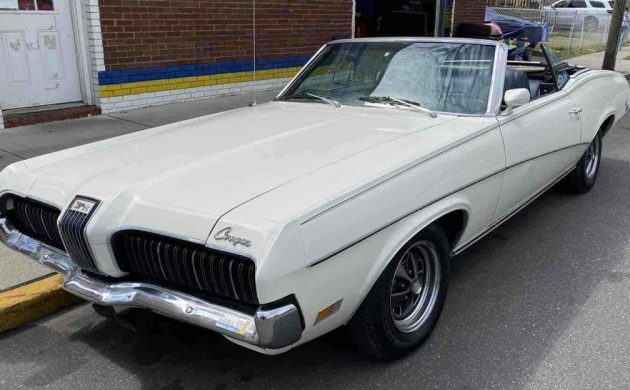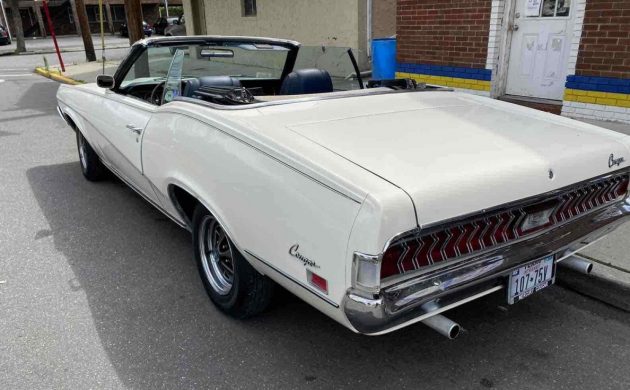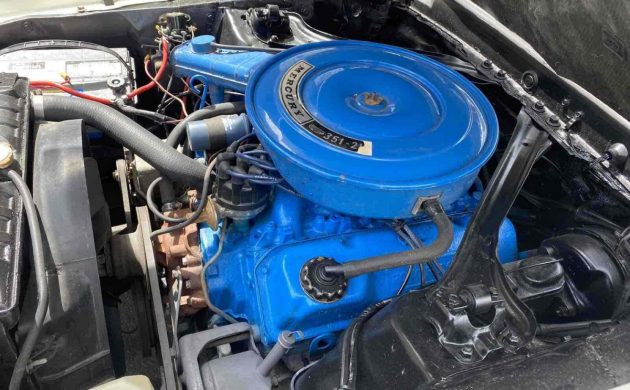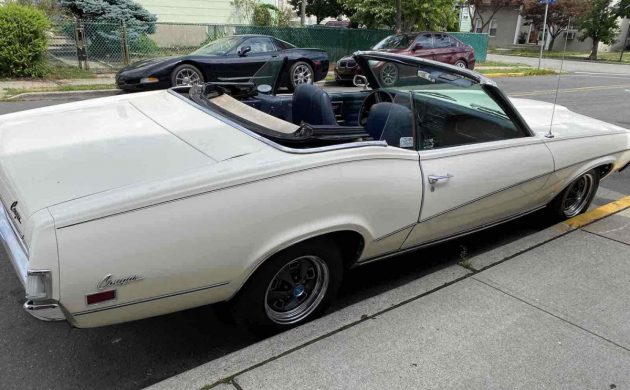The Mercury Cougar was a car that very nearly didn’t happen. Those who occupied the more opulent offices at Ford’s World Headquarters were not convinced that a Mustang cousin would sell in reasonable numbers. Eventually, they relented, and the 1st Generation Cougar became a hit with those seeking what was effectively a Mustang with a touch of luxury. This 1970 Cougar XR7 Convertible is from the final year of 1st Generation production, and it is a classic that seems to hold a lot of promise. The supplied photos show no significant rust problems, and the car is said to run and drive. The time has come for it to head to a new home, so this could be the chance to consider buying a cool Convertible that would grab its share of attention. The Mercury is located in Lodi, New Jersey, and has been listed for sale here on eBay. The auction has been set to open at $3,000, but there have been no bids. There is a BIN option available, and this has been set at $16,000. It is worth noting that this is the second time the Cougar has been listed for sale in recent weeks. The previous auction ended with bidding at $9,477 with the reserve unmet. While it is by no means a certainty, this sales history could mean that the reserve has been set at a lower level this time around.
If Mercury’s intent with the Cougar had been to produce a badge-engineered Mustang, then there is every chance that the project would never have seen the light of day. However, they sought to create a model with its own identity, a pony car with an added level of luxury. It also featured exterior styling queues that resulted in a vehicle with a distinctively different appearance to the Mustang on which it was based. This 1970 example carries all of those features, including a striking tail-light treatment, along with a unique grille and covered headlamps. The owner is pretty sparse with his information, but there are no apparent rust problems visible in the supplied photos. There is no information provided about the underside, but given its Mustang underpinnings, a potential buyer will need to ascertain whether there are any issues with the floors, frame rails, or the torque box region. The panels show no significant dings or dents, and while the Wimbledon White paint has a few flaws, it remains presentable for an original survivor. The story seems to be the same when you examine the chrome and the tinted glass, and I can’t see any reason why the car couldn’t be driven as it currently stands.
At first glance, the Cougar’s blue interior doesn’t look that bad. There are a few glaring flaws, including a badly cracked dash pad, along with a warped and discolored armrest on the console. When you start to look closer, there is a fair amount of plastic trim showing evidence of UV damage, while there is also a split in the driver’s seat. If a buyer wants to drive the car as a survivor, there is no reason why they couldn’t. If a buyer is keen on completing a restoration, but their budget is tight, then they could tackle an interior refurbishment as time and finances allow. It is serviceable, and there are quite a few pieces that could be restored for little cost. Items like the gauge lenses might be able to be cleaned and polished. Otherwise, a set of replacements cost less than $130 and would make a dramatic difference to the dash. If the next owner wanted to go the whole hog, then full trim kits are available. Thankfully, prices on these are comparable with the equivalent Mustang, which means that whipping the interior into shape isn’t likely to break the bank.
One of the significant differences between the Mustang and the Cougar was what was available under the hood. A budget-conscious buyer could access the Mustang lifestyle with a 6-cylinder engine under the hood. The smallest engine available in a Cougar until 1969 was the 289ci V8. This 1970 model features the H-Code 351ci V8. This pumped out 250hp, which found its way to the rear wheels via a 3-speed automatic transmission. In keeping with its softer image, driving chores were made more comfortable by fitting power steering and power front disc brakes. When it was new, the XR7 was good for a 16.2-second ¼ mile pass. The owner states that this Cougar runs and drives but doesn’t provide any insight into how well it performs either of these tasks. On the positive side of the ledger, I can’t see any visible evidence of long-term fluid leaks. What is clear is that someone has had a bit of a field day under the hood with the rattle cans. The quality of this work is, to be diplomatic, a bit ordinary. I am probably not alone in wishing that things had been left untouched because most of the paint will need to be stripped and reapplied if a high level of presentation is to be achieved. Still, at least it does look to be pretty clean.
As a project car, this 1970 Cougar XR7 Convertible does show a fair amount of promise. The owner hasn’t done himself any favors with the lack of information that he has provided. That is probably one of the primary reasons why it failed to sell when it was previously listed for sale. Potential buyers will have to hope that the owner is approachable and that he will be willing to answer a few questions about this classic. That being said, if it is rust-free, then it should represent a straightforward prospect for restoration. With good examples starting at $25,000 and values then climbing steadily to over $50,000 for pristine examples, it could be well worth the time and effort for a potential buyer to ask those questions. After all, it costs nothing to ask.







IMHO, the Cougar was a much better-looking car than the Mustang. I don’t understand why it doesn’t get the respect it deserves.
Sssh…don’t tell everybody. Let them have their 13-on-a-dozen Mustangs so there are still some great cars at payable $ left for us others that prefer the more sophisticated models 😁
I too prefer the Cougar over the Mustang.I have never driven a Cougar of this period but have heard they are quieter and more of a luxury car than a Mustang. And the front end with the hidden lights looks great coming down the road. Seems like a reasonable price to me
The sequential rear turn signals are awesome, too. However, the mechanical sequencing units are prone to fail after this many years and are expensive to service. The electronic replacements are worth it as long as you don’t plan on showing the car.
Ray, the mechanical units were gone by ’70. They used an electronic sequencer circuit. However, they are still prone to issues, mainly due to aging of the relays and turn signal switches. Upgrading to modern electronics is easy, but not cheap for ’70 due to the flashing side markers.
Ray, the mechanical sequential units were replaced by electronics by the time ’70 rolled around. But they are still prone to problems. Upgrading to modern electronics is easy, but not really cheap ~ at least for ’70, due to the flashing side marker lights.
Curious as to why no mileage is mentioned.
70254
First off, it’s not an XR-7. It’s a Standard (meaning base model / non-XR7) convertible.
Standard convertibles all received the Décor Interior with comfortweave seat surfaces while XR-7’s had a leather interior. XR-7’s also received upgraded instrumentation and a passenger side dash clock.
Good looking car though! Give is a deep cleaning and drive the heck out of it!
Right. Just a standard convertible. I have a blue over blue 1970 xr7 convertible. Leather seats, pasenger clock, “rosewood” inlays, rocker switches in the panel in the top center of the dash, tilt column, and a “rimblow” steering wheel.
At least this one has the 351C. Means it should have a C6 auto and a 9 inch rear. I have no idea how both the 351C and 351W both made 250 hp. The 351C ports and valves are huge compared to the 351W.
FMX was still the small block transmission that year.
I see potential here for a reasonably priced convertible that needs some tlc and elbo grease. Cougars especially the 67-68 models hold great appeal to me, but these larger models can be quite striking as well. If this car can be purchased for around 10 grand it would be hard to beat value wise in the classic car market. You will find yourself the center of attention at most car and coffee spots, so it would be to your advantage to be well read up on the car to answer questions.
God bless America
When developing the Mustang one of the names was Cougar. Also I think the base engine by 1969 was the 302. The 289 being fazed out in 1968.
Wasn’t the Camaro going to be called ‘Cougar’ as well?
Oh wait, it was ‘Panther’, wrong animal!
Base engine for Cougar in ’69 & ’70 was the 351-2V. The only 302 offered for ’69/’70 was the Boss 302, which was only available with the Eliminator Option.
my first car in high school was a 70 Cougar Eliminator. Loved that car and had it for yrs.
My sister had a xr7 hardtop like this but with a black vinyl top and blk interior, loaded. Originally she had my Eliminator, but I took it from her with the agreement I find her a similar car to replace it with. So I found the XR7 and we traded. Ill own another hardtop again.
What ended up happening to your Eliminator?
Looks nice, but probably needs a top. That’s really not a hard job and If you buy the top, you’ll find they aren’t that expensive. Actually installing the top isn’t tough at all. Just take your time and follow any of You Tube videos.
Other than that, it’s just a nice weekend car.
Standard engine for the Cougar in ’69 was the 351 Windsor 2-barrel (or 2V in Ford parlance). The 351W 4-barrel and 428 CJ were optional. For ’70, both 351s were the new “Cleveland” version, although some 351Ws went into early cars, I believe. For both years, a 351 4-barrel was standard in the Eliminator, which was the only Cougar version to offer the Boss 302 as an option.
Jim, for ’70 if you optioned the 351-4V you got a Cleveland. The base 351-2V could be either a Windsor or a Cleveland. Ford kept track of which 2V cars got W or C, and it will show up on a Marti Report. But they both got the same “H-code” designation, which I imagine caused hell at the dealership or auto parts store!
Where is the Marti Report for this ‘XR-7’?
Who should I email for questions?
It’s definitely NOT an XR-7.
If it were it would have XR-7 tags on the front center grill, on the right side of the trunk lid and on the passenger side of the dash.
It would also have a rally clock on the passenger side. The instrument panel would have a tachometer next to the speedometer.
Top center of the dash would have vertical rocker switches instead of idiot lights.
He claims it’s original. I don’t believe the color was white. In the trunk I see blue which indicates it was originally blue.
The vin lists it as a standard convertible, made in Michigan, with a 351 Windsor (H code) motor and not a Cleveland (M code).
Still looks to be a nice car.
Ford Mercury Cougar Xr7 – VIN Decoder
As noted before, the H code is a 351 2V which could be either a Windsor or Cleveland. Mine came with a Cleveland. There’s no way they made the same amount of power and torque, but Ford also said that the 427 8V only made 25 more hp than the 427 4V and the same amount of torque…hmmm.
Is this a “heater delete” car?
No. The heater on the ’69 & ’70 only blows up for defrost or down for floor heat. No dash vents at all, except if you had AC or “Comfort Stream” (an option in ’69 but not ’70).
“Heater Delete” was only available on cars destined for Hawaii and that did not have the AC option (heat and AC shared controls and duct work).